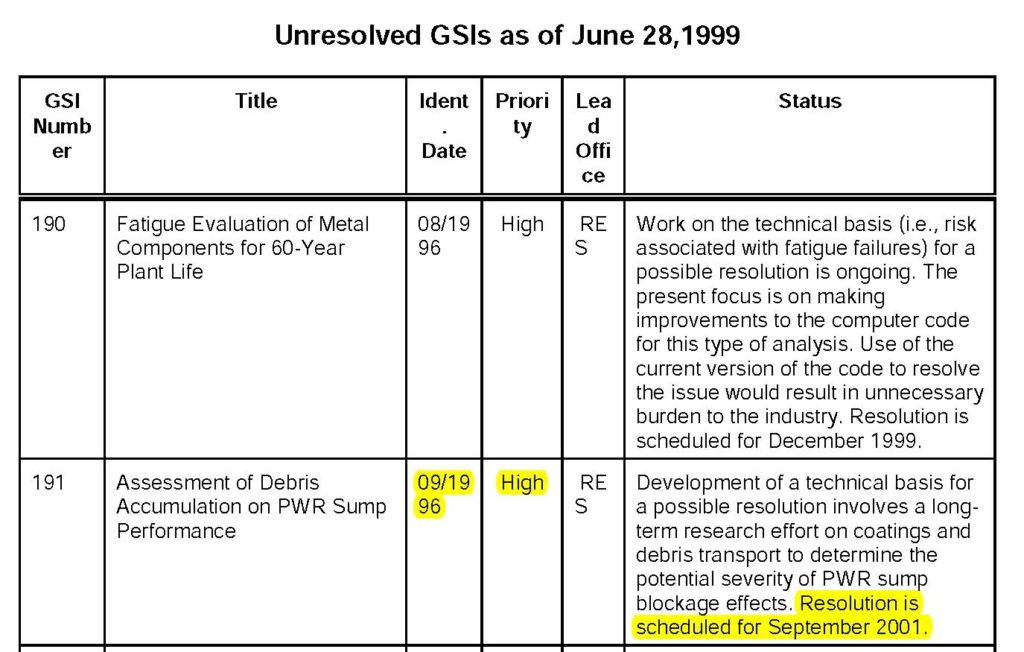Who says the Nuclear Regulatory Commission does not have a delightful sense of humor?
Not me. Not anymore. Not after stumbling across the NRC’s Generic Issues Dashboard on its website.
The Dashboard page shows the status of three open generic issues. I look at two of them here.
GI204: Flooding of nuclear sites
Generic Issue (GI) 204 was initiated due to concerns that failure of dams upriver from nuclear power plants could flood the sites and disable emergency systems needed to prevent reactor core damage. The NRC staff completed a screening analysis in July 2011 and formally accepted GI-204 in February 2012, nine months after flooding at Fukushima Daiichi caused the three reactors operating at the time to melt down.
So, what’s the status of the resolution of this generic issue six years later? Dashboard, please.

Fig. 1 (Source: Nuclear Regulatory Commission)
A whopping 13.1% of the affected reactors have implemented the fixes. That’s a racy rate of over 2% per year sustained for six whole years!
How many of the affected reactors have completed all the effort needed to resolve this safety issues? Three—South Texas Project Units 1 and 2 and Callaway.
But that’s a recent generic issue. Let’s examine an older generic issue.
GI-191: Debris accumulation
GI-191 was identified in September 1996 and was assigned High priority by June 28, 1999, with a target resolution of September 2001. GI-191 affected all the 69 pressurized water reactors operating in the U.S. at the time.
If a pipe connected to the reactor vessel broke, the fluid jetting out of the pipe ends would scour insulation off piping, coatings off equipment, and even paint off walls. This debris would then be carried by the water to the basement of the containment building where it could collect in the sump. The emergency pumps for PWRs draw water from the containment sump. The amount of debris transported to the sump could block the flow to the emergency pumps, disabling both reactor core cooling and containment cooling.

Fig. 2 (Source: Nuclear Regulatory Commission SECY-99-185)
So, what’s the status of this High priority generic issue more than 16 years after its target resolution date of September 2001? Dashboard, please.

Fig. 3 (Source: Nuclear Regulatory Commission)
Less than half of the affected reactors have reportedly implemented the fixes to this High priority safety problem more than two decades after it was identified. And the NRC has verified the adequacy of the fixes at less than 35 percent of the affected reactors. And for all we know, the NRC is taking credit for the issue no longer being unresolved at PWRs like Crystal River 3, Kewaunee, San Onofre Units 2 and 3, and Fort Calhoun that have permanently shut down since GI-191 became a High priority or the statistics would reflect even worse.
UCS Perspective
Dashboard? Very funny. Not very accurate, but very amusing.
Come on. A safety problem afflicting more than half the nation’s nuclear power reactors that remains unresolved at most of them more than two decades later cannot be monitored by anything having “Dash” in its title. Unless “Dash” is paired with a verb that prevents any one from inferring that swiftness is involved.
Like “DashBored.”
DashBored might better convey the NRC’s efforts—they started out really and truly wanting to quickly resolve these known safety problems to protect the American public from unduly elevated risks, but then they got bored. Something else came up, like certifying new reactor designs and approving 20-year extensions to the operating licenses of problem-plagued reactors.
The dashboard of a competent nuclear safety regulator would not show known safety problems to remain unresolved for so long.
